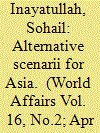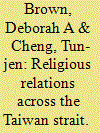|
|
|
Sort Order |
|
|
|
Items / Page
|
|
|
|
|
|
|
| Srl | Item |
| 1 |
ID:
118931


|
|
|
| 2 |
ID:
110159


|
|
|
|
|
| Publication |
2012.
|
| Summary/Abstract |
This study of Buddhist, Taoist, and Christian relations across the Taiwan Strait elicits three observations: (1) officials on both sides of the Strait are permitting increased cross-Strait religious interaction, but each side has different calculations for doing so; (2) each side uses religion as "soft power" to obtain its political objectives, but these low-key approaches are limited-for different reasons; and (3) even though cross-Strait religious ties are defined by the governments and religious organizations in Taiwan and China in cultural terms, they have significant political implications.
Religious relations across the Taiwan Strait are under-studied and under-reported. Yet cross-Strait religious interaction can have important consequences, such as social integration or pressures on both Beijing and Taipei for changed policies and practices. For Beijing, religious relationships are one of five key links on which Hu Jintao's government has focused attention in an effort to build a harmonious society.1 For Taipei, friendly cross-Strait religious relations help to achieve détente with China.
The study elicits three observations. The first is that officials on both sides of the Strait are permitting increased cross-Strait religious interaction, but each side has different calculations for doing so. From the Taiwan side, accommodation of increasing religious exchanges is instrumental to peace with China, and perhaps to inducing China's political liberalization. In Beijing, officials use cross-Strait religious ties as a non-threatening means to draw Taiwan closer to unification.
The second observation is that each side of the Strait uses religion as "soft power" to obtain its political objectives, but these low-key approaches are limited. Taiwan's approach is circumscribed because China in significant ways controls and manipulates cross-Strait religious exchanges. Some people of Taiwan find the call from China to honor their historical roots by connecting with religious sites in the "motherland" particularly compelling. This strategy, too, is limited, however, because of the intellectual and organizational growth that has been attained by many of Taiwan's religious institutions.
The third observation is that even though cross-Strait religious ties are defined in cultural terms by both governments and religious organizations in Taiwan and China, they have significant potential political implications. Because Taiwan is a democracy, the government in Taipei cannot pry into its citizens' private business, and therefore monitors only Chinese visitors who come to Taiwan for religious purposes. Taiwan has no knowledge of the number of visits made by its people to China that involve religious exchanges. In contrast, the government in Beijing guards against challenges that can arise from religions, and maintains vigilance about all religious interactions in both directions across the Strait. Governments and religious organizations on both sides of the Strait are aware of the increased religious interactions, but every player is mindful that religious organizations and exchanges can be the micro-foundation for political change.
The focus of this study is on Buddhism, Taoism, and Christianity. Ninety-three percent of Taiwan's religious population practices Buddhism and Taoism. Only 4.5 percent practices Christianity, but Christians have wielded substantial influence in Taiwan's social development and political history. Only 2.5 percent of the religious population professes a religion other than Buddhism, Taoism, and Christianity. The article discusses the ways in which cross-Strait religious relations are unfolding, and considers the political implications in regard to each of the three religions. The conclusion summarizes the systematic analysis of the patterns of interactions and their political connotations.
|
|
|
|
|
|
|
|
|
|
|
|
|
|
|
|
|
|
|
|
|